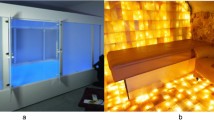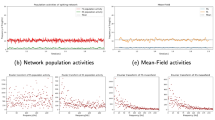Summary
Two main types of neurons were recorded in the dorsal hippocampus of chronic rats. Type I neurons were characterized by a bursting mode of discharge. Their activity was higher during slow wave sleep (SWS) than during wakefulness (W) or paradoxical sleep (PS). They had an “inhibitory” response (decrease in spike frequency) to desynchronizing stimuli presented during a SWS episode. Type II neurons had a mean spike frequency greater than 10/s. Some of them, (group IIa), were more active during W and PS than during SWS and had an “excitatory” response (increase in spike frequency) to desynchronizing stimuli. Activity of other type II neurons, group IIb, had no relationship with the arousal level.
An arousal response (neocortical EEG desynchrony) was classically conditioned to an acoustical CS. During that conditioning, most of the type I neurons rapidly displayed an inhibitory conditioned response (CR). This unit response was closely associated with the EEG CR. The majority of the type II neurons did not demonstrate signs of conditioning (group IIb). The others, group IIa, gradually developed an excitatory CR at moderate levels. This unit CR seemed to be independent of conditioned modifications of arousal.
Similar content being viewed by others
References
Albe-Fessard, D., Stutinsky, F., Libouban, S.: Atlas stéréotaxique du diencéphale du rat blanc. Paris: Editions du CNRS 1966.
Alger, B.E., Teyler, T.J.: Long-term and short-term plasticity in the CA-1, CA-3, and dentate regions of the rat hippocampal slice. Brain Res. 110, 463–480 (1976).
Andersen, P., Lomo, T.: Mode of activation of hippocampal pyramidal cells by excitatory synapses on dendrites. Exp. Brain Res. 2, 247–260 (1966).
Andersen, P., Sundberg, S.H., Sveen, O., Wigstrom, H.: Specific long-lasting potentiation of synaptic transmission in hippocampal slices. Nature 266, 736–737 (1977).
Assaf, S.Y., Miller, J.J.: Neuronal transmission in the dentate gyrus: role of inhibitory mechanisms. Brain Res. 151, 587–592 (1978a).
Assaf, S.Y., Miller, J.J.: The role of a Raphe serotonin system in the control of septal unit activity and hippocampal desynchronization. Neuroscience 3, 539–550 (1978b).
Berger, T.W., Alger, B., Thompson, R.F.: Neuronal substrate of classical conditioning in the hippocampus. Science 192, 483–485 (1976).
Berger, T.W., Thompson, R.F.: Identification of pyramidal cells as the critical elements in hippocampal neuronal plasticity during learning. Proc. Nat. Acad. Sci. (Wash.) 75. 1572–1576 (1978).
Best, M.R., Best, P.J.: The effect of state of consciousness and latent inhibition on hippocampal unit activity in the rat during conditioning. Exp. Neurol. 51, 564–573 (1976).
Bliss, T.V.P., Gardner-Medwin, A.R.: Long-lasting potentiation of synaptic transmission in the dentate area of the unanesthetized rabbit following stimulation of the perforant path. J. Physiol. (Lond.) 232, 357–374 (1973).
Costa, J.C., Delacour, J. Enregistrement d'activités unitaires et multi-unitaires chez le rat “chronique”. Physiol. Behav. 16, 497–499 (1976).
Dunwiddie, T., Lynch, G.: Long-term potentiation and depression of synaptic responses in the rat hippocampus: localization and frequency dependency. J. Physiol. (Lond.) 276. 353–367 (1978).
Fox, S.E., Ranck, J.B.: Localization and anatomical identification of theta and complex spike cells in dorsal hippocampal formation of rats. Exp. Neurol. 49, 299–313 (1975).
Hirano, T., Best, P., Olds, J.: Units during habituation, discrimination learning, and extinction. Electroencephalogr. Clin. Neurol. 28, 127–135 (1970).
Lidsky, T.I., Levine, M.S., MacGregor, S.: Hippocampal units during orienting and arousal in rabbits. Exp. Neurol. 44, 171–186 (1974).
Lindsley, D.B., Wilson, C.L.: Brain stem-hypothalamic systems influencing hippocampal activity and behavior. In: The hippocampus, Isaacson, R.L., Pribram K.H. (eds.), Vol. 2, pp. 247–278. New York, London: Plenum Press 1975.
Lømo, T.: Patterns of activation in a monosynaptic cortical pathway: the perforant path input to the dentate area of the hippocampal formation. Exp. Brain Res. 12, 18–45 (1971).
Lomo, T.: Potentiation of monosynaptic EPSP in the perforant path-dentate granule cell synapse. Exp. Brain Res. 12, 46–63 (1971).
Lynch, G.S., Dunwiddie, T.V., Gribkoff, V.K.: Heterosynaptic depression: a post-synaptic correlate of long-term potentiation. Nature 266, 737–739 (1977).
Mays, L.E., Best, P.J.: Hippocampal unit activity to tonal stimuli during arousal from sleep and in awake rats. Exp. Neurol. 47, 268–279 (1975).
Olds, J., Hirano, T.: Conditioned responses of hippocampal and other neurons. Electroencephalogr. Clin. Neurol. 26, 159–166 (1969).
Olds, J., Mink, W.D., Best, P.J.: Single unit patterns during anticipatory behavior. Electroencephalogr. Clin. Neurol. 26, 144–158 (1969).
Olds, J., Disterhoft, J.F., Segal, M., Kornblith, C.L., Hirsh, R.: Learning centers of rat brain mapped by measuring latencies of conditioned unit responses. J. Neurophysiol. 35, 202–219 (1972).
Phillips, I.: Brain unit activity during behavior. Springfield: Thomas 1973.
Ranck, J.B.: Studies on single neurons in dorsal hippocampal formation and septum in unrestrained rats. Part I: Behavioral correlates and firing repertoires. Exp. Neurol. 41, 461–531 (1973).
Segal, M., Disterhoft, J.F., Olds, J.: Hippocampal unit activity during classical aversive and appetitive conditioning. Science 175, 792–794 (1972).
Segal, M., Bloom, F.E.: The action of Norepinephrine in the rat hippocampus. IV. The effect of Locus Coeruleus stimulation on evoked hippocampal unit activity. Brain Res. 107, 513–525 (1976).
Steward, O., White, W.F., Cotman, C.W., Lynch, G.: Potentiation of excitatory synaptic transmission in the normal and the reinnervated dentate gyrus. Exp. Brain Res. 26, 423–441 (1976).
Vinogradova, O.: Registration of information and the limbic system. In: Short-term changes in neural activity and Behaviour, Horn, G., Binde, R.A. (eds.), pp. 95–140. Cambridge: Cambridge University Press 1970.
Winson, J., Abzug, C.: Gating of neuronal transmission in the hippocampus: efficacity of transmission varies with behavioral state. Science 196, 1223–1225 (1977).
Author information
Authors and Affiliations
Rights and permissions
About this article
Cite this article
Delacour, J. Conditioned modifications of arousal and unit activity in the rat hippocampus. Exp Brain Res 38, 95–101 (1980). https://doi.org/10.1007/BF00237935
Received:
Issue Date:
DOI: https://doi.org/10.1007/BF00237935




